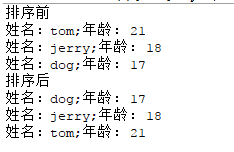Comparable与Comparator源码分析
package java.lang;
import java.util.*; /**
* This interface imposes a total ordering on the objects of each class that
* implements it. This ordering is referred to as the class's <i>natural
* ordering</i>, and the class's <tt>compareTo</tt> method is referred to as
* its <i>natural comparison method</i>.<p>
*
* Lists (and arrays) of objects that implement this interface can be sorted
* automatically by {@link Collections#sort(List) Collections.sort} (and
* {@link Arrays#sort(Object[]) Arrays.sort}). Objects that implement this
* interface can be used as keys in a {@linkplain SortedMap sorted map} or as
* elements in a {@linkplain SortedSet sorted set}, without the need to
* specify a {@linkplain Comparator comparator}.<p>
*
* The natural ordering for a class <tt>C</tt> is said to be <i>consistent
* with equals</i> if and only if <tt>e1.compareTo(e2) == 0</tt> has
* the same boolean value as <tt>e1.equals(e2)</tt> for every
* <tt>e1</tt> and <tt>e2</tt> of class <tt>C</tt>. Note that <tt>null</tt>
* is not an instance of any class, and <tt>e.compareTo(null)</tt> should
* throw a <tt>NullPointerException</tt> even though <tt>e.equals(null)</tt>
* returns <tt>false</tt>.<p>
*
* It is strongly recommended (though not required) that natural orderings be
* consistent with equals. This is so because sorted sets (and sorted maps)
* without explicit comparators behave "strangely" when they are used with
* elements (or keys) whose natural ordering is inconsistent with equals. In
* particular, such a sorted set (or sorted map) violates the general contract
* for set (or map), which is defined in terms of the <tt>equals</tt>
* method.<p>
*
* For example, if one adds two keys <tt>a</tt> and <tt>b</tt> such that
* {@code (!a.equals(b) && a.compareTo(b) == 0)} to a sorted
* set that does not use an explicit comparator, the second <tt>add</tt>
* operation returns false (and the size of the sorted set does not increase)
* because <tt>a</tt> and <tt>b</tt> are equivalent from the sorted set's
* perspective.<p>
*
* Virtually all Java core classes that implement <tt>Comparable</tt> have natural
* orderings that are consistent with equals. One exception is
* <tt>java.math.BigDecimal</tt>, whose natural ordering equates
* <tt>BigDecimal</tt> objects with equal values and different precisions
* (such as 4.0 and 4.00).<p>
*
* For the mathematically inclined, the <i>relation</i> that defines
* the natural ordering on a given class C is:<pre>
* {(x, y) such that x.compareTo(y) <= 0}.
* </pre> The <i>quotient</i> for this total order is: <pre>
* {(x, y) such that x.compareTo(y) == 0}.
* </pre>
*
* It follows immediately from the contract for <tt>compareTo</tt> that the
* quotient is an <i>equivalence relation</i> on <tt>C</tt>, and that the
* natural ordering is a <i>total order</i> on <tt>C</tt>. When we say that a
* class's natural ordering is <i>consistent with equals</i>, we mean that the
* quotient for the natural ordering is the equivalence relation defined by
* the class's {@link Object#equals(Object) equals(Object)} method:<pre>
* {(x, y) such that x.equals(y)}. </pre><p>
*
* This interface is a member of the
* <a href="{@docRoot}/../technotes/guides/collections/index.html">
* Java Collections Framework</a>.
*
* @param <T> the type of objects that this object may be compared to
*
* @author Josh Bloch
* @see java.util.Comparator
* @since 1.2
*/
public interface Comparable<T> {
public int compareTo(T o);
}
实现这个接口的类的集合或数组将会被自动排序通过Collections.sort或者Arrays.sort。同时,这个对象也可以被用来做Map或者Set的键值,而不需要另外制定一个比较器。
废话不多说了,直接举例子。
package object;
public class Person implements Comparable<Object>{
private String name;
private int age;
Person(String name,int age){
this.name=name;
this.age=age;
}
public int getAge() {
return age;
}
public void setAge(int age) {
this.age = age;
}
public String getName() {
return name;
}
public void setName(String name) {
this.name = name;
} @Override
public String toString() {
return "姓名:"+this.name +";年龄: " + this.age;
}
@Override
public int compareTo(Object o) {
Person temp =null;
if(o instanceof Person )
temp = (Person)(o);
return this.age - temp.age;
}
}
测试类:
public class Test{
@org.junit.Test
public void test(){
Person[] people = {new Person("tom",21),new Person("jerry",18),new Person("dog",17)};
System.out.println("排序前");
for(Person p:people)
System.out.println(p);
System.out.println("排序后");
java.util.Arrays.sort(people);
for(Person p:people)
System.out.println(p);
}
}
结果:

大家可以看到,这个排序方法是放到排序的对象类里面的,但是如果我们已经设计好了某类,而且不想改变其数据结构,就这可以用到比较器Comparator。用 Comparator 是策略模式,就是不改变对象自身,而用一个策略对象来改变它的行为。
package java.util; import java.io.Serializable;
import java.util.function.Function;
import java.util.function.ToIntFunction;
import java.util.function.ToLongFunction;
import java.util.function.ToDoubleFunction;
import java.util.Comparators; @FunctionalInterface
public interface Comparator<T> { int compare(T o1, T o2);
boolean equals(Object obj); }
Comparator里面只有两个无实现体的接口方法,其它的方法有实现体,好像是新特性,暂时未用到。这里的equals与Object的equals方法类似。所以对于实现这个接口的类不必实现equals方法,也不会报错。
下面的例子我用的是匿名函数。
package object;
public class Person{
private String name;
private int age;
Person(String name,int age){
this.name=name;
this.age=age;
}
public int getAge() {
return age;
}
public void setAge(int age) {
this.age = age;
}
public String getName() {
return name;
}
public void setName(String name) {
this.name = name;
} @Override
public String toString() {
return "姓名:"+this.name +";年龄: " + this.age;
}
}
测试类:
public class Test{
@org.junit.Test
public void test(){
Person[] people = {new Person("tom",21),new Person("jerry",18),new Person("dog",17)};
System.out.println("排序前");
for(Person p:people)
System.out.println(p);
System.out.println("排序后");
Arrays.sort(people, new Comparator<Person>() {
public int compare(Person o1, Person o2) {
return o1.getAge()-o2.getAge();};
});
for(Person p:people)
System.out.println(p);
}
}
结果:

总结:
用Comparable 简单, 只要实现Comparable 接口的对象直接就成为一个可以比较的对象,但是需要修改源代码,用Comparator 的好处是不需要修改源代码,而是另外实现一个比较器,当某个自定义的对象需要作比较的时候,把比较器和对象一起传递过去就可以比大小了,并且在Comparator 里面用户可以自己实现复杂的可以通用的逻辑,使其可以匹配一些比较简单的对象,那样就可以节省很多重复劳动了。
Comparable与Comparator源码分析的更多相关文章
- 【集合框架】JDK1.8源码分析之Comparable && Comparator(九)
一.前言 在Java集合框架里面,各种集合的操作很大程度上都离不开Comparable和Comparator,虽然它们与集合没有显示的关系,但是它们只有在集合里面的时候才能发挥最大的威力.下面是开始我 ...
- java中Comparator比较器顺序问题,源码分析
提示: 分析过程是个人的一些理解,如有不对的地方,还请大家见谅,指出错误,共同学习. 源码分析过程中由于我写的注释比较啰嗦.比较多,导致文中源代码不清晰,还请一遍参照源代码,一遍参照本文进行阅读. 原 ...
- HashMap与TreeMap源码分析
1. 引言 在红黑树--算法导论(15)中学习了红黑树的原理.本来打算自己来试着实现一下,然而在看了JDK(1.8.0)TreeMap的源码后恍然发现原来它就是利用红黑树实现的(很惭愧学了Ja ...
- 【集合框架】JDK1.8源码分析之TreeMap(五)
一.前言 当我们需要把插入的元素进行排序的时候,就是时候考虑TreeMap了,从名字上来看,TreeMap肯定是和树是脱不了干系的,它是一个排序了的Map,下面我们来着重分析其源码,理解其底层如何实现 ...
- 【集合框架】JDK1.8源码分析之Collections && Arrays(十)
一.前言 整个集合框架的常用类我们已经分析完成了,但是还有两个工具类我们还没有进行分析.可以说,这两个工具类对于我们操作集合时相当有用,下面进行分析. 二.Collections源码分析 2.1 类的 ...
- 【JUC】JDK1.8源码分析之ConcurrentSkipListMap(二)
一.前言 最近在做项目的同时也在修复之前项目的一些Bug,所以忙得没有时间看源代码,今天都完成得差不多了,所以又开始源码分析之路,也着笔记录下ConcurrentSkipListMap的源码的分析过程 ...
- Java中Comparable和Comparator接口区别分析
Java中Comparable和Comparator接口区别分析 来源:码农网 | 时间:2015-03-16 10:25:20 | 阅读数:8902 [导读] 本文要来详细分析一下Java中Comp ...
- Java集合源码分析(六)TreeSet<E>
TreeSet简介 TreeSet 是一个有序的集合,它的作用是提供有序的Set集合.它继承于AbstractSet抽象类,实现了NavigableSet<E>, Cloneable, j ...
- Java集合类源码分析
常用类及源码分析 集合类 原理分析 Collection List Vector 扩充容量的方法 ensureCapacityHelper很多方法都加入了synchronized同步语句,来保 ...
随机推荐
- IIS7部署网站的一些细节问题。
1.不能在此路径中使用此配置节.如果在父级别上锁定了该节,便会出现这种情况. 这个错误的原因是在 IIS 7中 采用了更安全的 web.config 管理机制,默认情况下会锁住配置项.要取消锁定可以以 ...
- I2C controller core之Bit controller(05)
6 generate statemachine 1 -- port cmd_ack : out std_logic; -- command completed 4 -- architecture ty ...
- 不能访问windows installer 服务,可能你在安全模式下运行 windows ,或者windows installer
windows installer服务解决方案 很多朋友在安装MSI格式的文件包时,经常会遇到windows installer出错的情况,有如下几种现象: 1.所有使用windows install ...
- 3D模型在UI上显示的方法(Unity)
方法:使用RawImage通过Render Texter将摄像机下的物体渲染纹理记录并显示在RawImage上面 具体实现:新建一个模型(Cube),新建一个摄像机,将Clear Flags设置为So ...
- [置顶]
我的 Java 后端书架 (2016 年暖冬版)
转自: http://calvin1978.blogcn.com/articles/bookshelf16.html 我的 Java 后端书架 (2016 年暖冬版) 本书架主要针对 Java 后端 ...
- 关于node对文件的读取
设计: 通过终端git / cmd 获取用户输入路径,然后遍历路径下所有的文件,打印输出. 因为需要命令行交互,所以引入prompt库 (https://github.com/flatiron/pro ...
- NLTK学习笔记(二):文本、语料资源和WordNet汇总
目录 语料库基本函数表 文本语料库分类 常见语料库及其用法 载入自定义语料库 词典资源 停用词语料库 WordNet面向语义的英语字典 语义相似度 语料库基本函数表 示例 描述 fileids() 语 ...
- Ubuntu14.043下QT5.5的安装与一点问题
请注明来自于 http://www.cnblogs.com/usegear/p/5100720.html 1.下载qt-opensource-linux-x86-5.5.0.run(去教育镜像网站下载 ...
- 【例题 4-5 uva 512】Spreadsheet Tracking
[链接] 我是链接,点我呀:) [题意] 在这里输入题意 [题解] 每个操作对与一个点来说变化是固定的. 因此可以不用对整个数组进行操作. 对于每个询问,遍历所有的操作.对输入的(x,y)进行相应的变 ...
- 浅析IT系统监控方法和应用
浅析IT系统监控方法和应用 http://blog.csdn.net/zhangman117/article/details/35549363
